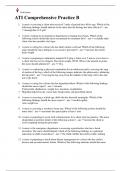Samenvatting
Summary Introduction to European Governance + additional literature 630027-B-6
- Vak
- Instelling
- Boek
This is a comprehensive summary of the chapters 1-12 of the book The Politics of the European Union by Herman Lelieveldt and Sebastiaan Princen. It includes some notes that were made during the lectures. it also includes the following articles: an opinion piece by Alberto Alemanno, an article by Gr...
[Meer zien]













